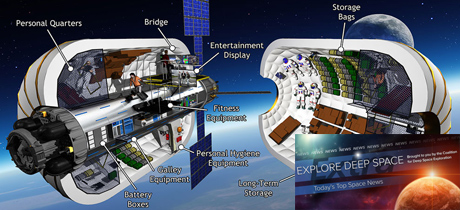In Today’s Deep Space Extra… U.S. aerospace companies are working with NASA to develop habitats for future human deep space explorers. Japan’s Hayabusa 2 spacecraft descends to the asteroid Ryugu for small lander deployments. Northrop Grumman test fires new solid rocket motor in Utah desert.
Human Space Exploration
Look inside a deep space habitat for NASA to take astronauts to Mars
Coalition Members in the News – Boeing, Lockheed Martin, NanoRacks, Northrop Grumman
CNBC (9/19): Companies partnered with NASA for a NextSTEP effort to develop an astronaut habitat for a human tended, lunar orbiting Gateway to be assembled in the 2020s have begun to offer renderings of their proposals. The participants include Bigelow Aerospace, Boeing, Lockheed Martin, NanoRacks, Northrop Grumman Innovation Systems and Sierra Nevada.
Ivanka Trump tours NASA’s Johnson Space Center on Thursday
Houston Chronicle (9/20): Ivanka Trump, the president’s daughter, was joined by NASA Administrator Jim Bridenstine, and three Houston area lawmakers on Thursday for a tour of NASA’s Johnson Space Center (JSC). The visit included a call to the crew of the International Space Station (ISS), in which Ivanka Trump noted that she’s harbored a lifelong desire to be an astronaut. She praised the Station’s six men and women for their inspiration and met with NASA interns at JSC and discussed the value of STEM education.
Astronaut says one thing might stop artists from visiting the Moon with SpaceX
Global News (9/19): Former NASA shuttle astronaut Jeff Hoffman, an MIT astronautics professor, has a word of caution for SpaceX lunar space tourist aspirant Yusaku Maezawa — a trip around the Moon aboard the company’s Big Falcon Rocket (BFR), could be a health challenge. Maezawa, a Japanese fashion designer, intends to invite an array of artists to accompany him on the proposed mission unveiled by SpaceX founder Elon Musk on Monday.
Space Science
Hayabusa2 asteroid probe deploys rovers
NHK World (9/20): Japan’s space agency JAXA says its Hayabusa2 probe has released its first pair of rovers designed to land on the asteroid Ryugu. JAXA officials say they’ll likely know on Saturday, Japan time, whether the MINERVA-II-1 rovers have successfully landed on the asteroid, through images beamed back to Earth. The landing is aimed at testing the rovers’ propulsion method and taking pictures of the asteroid’s surface to use for the planned landing of the probe in late October. The Hayabusa2 is carrying two more robotic vehicles.
ScanMars demonstrates water detection device for astronauts on Mars
Physics.org (9/20): An Italian developed ground penetrating radar instrument, ScanMars, could help to identify where to dig on Mars for subsurface water. The instrument was tested in Oman during a space mission simulation.
Other News
Northrop Grumman’s GEM 63 undergoes 1st test fire
Coalition Members in the News – Northrop Grumman, United Space Alliance
Spaceflightinsider.com (9/20): Northrop Grumman’s Graphic Epoxy Motor GEM 63 was ignited Thursday in Promontory, Utah, as part of a sequence of tests to prepare a family of solid rocket motors for their role in the future launchings of the United Launch Alliance Atlas V and Vulcan rockets. The ground test spanned 115 seconds and simulated rocket loads experienced during actual flight.
Watch a satellite net a cubesat in awesome space junk cleanup test
Space.com (9/20): Earlier this week, the European Remove Debris experiment demonstrated a capability to actively remove space junk from Earth orbit. A small sat played the part of the actual debris with was snagged with a net from the Remove Debris spacecraft. The technology demonstration hardware was launched to the International Space Station (ISS) in April and deployed by astronauts in June.
Expansion of China’s Beidou satellite fleet continues with successful launch
Spaceflightnow.com (9/20): China on Wednesday successfully launched two more satellites for its expanding Beidou satellite global navigation system. The latest satellites were the first in the 14 spacecraft, third generation Beidou network with search and rescue capabilities.

